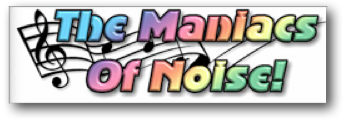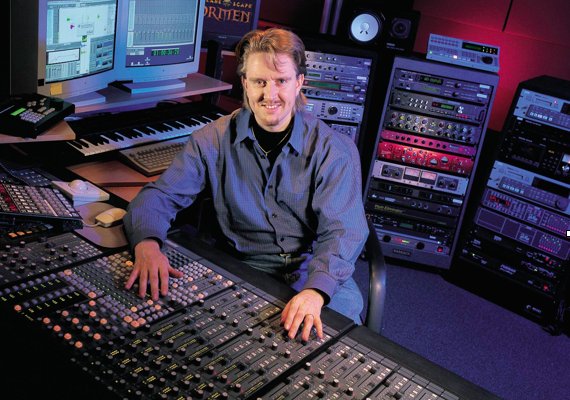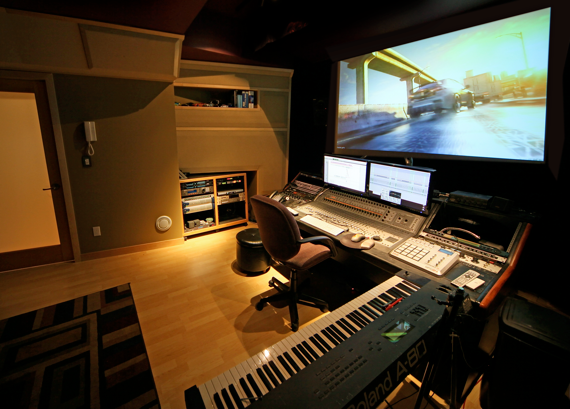
Designing Sound: Hi Charles, first of all, would be great to have an introduction about your career. How did you start, how you grow up in the sound world, and so on…
Charles Deenen: Thanks for the invite! We’ll have a fun month together with (hopefully) lots of usable info.
I’ve been called an old fella by some young folks in the industry, so am getting up there in age. I grew up in the netherlands and around 1983, attempted to start doing audio on a computer. That was the era of Commodore PET, so I tried to get tolerable sound out of a single-beep CBM-PET, and oh my, that didn’t go so well, LOL. Soon after acquiring a C64, I started to make music/graphic demos, through which I met Jeroen Tel. We wanted to make our own music, and wrote a music-driver for the Commodore 64. Well, this led to us having the “odd” idea that maybe we could make money doing this. You know, maybe just enough to pay for some gum and floppy-disks. There we travelled as young teenagers, all dressed up, to the european computer show in London where Hewson gave us our first paid gig. Apparently they liked what we did, and this led to many more jobs from a wide range of companies. Initially, I mainly provided the sound-effects for the titles which we did, but soon had to delve into doing music. Well, I knew nothing about music. I knew that a C major sounded OK after a D minor, that’s about it, LOL. However, funny enough the first music pieced I did wasn’t bad, and started doing more and more.

In the late 80‘s our company “Maniacs of Noise” had to begin sub-contracting, and at its peak had 5 people making musical noise at once. Considering those early computer-game years, that was huge. During those time, computer games were not nearly as main-stream as now. Zzap 64 was about the only magazine dedicated to gaming, and a game development team was 3-4 people. We provided music and/or sfx for over a hundred games on Commodore 64, 128, Amiga, Atari ST and Spectrum.
In 1990, one of the projects we did was “Dragon’s War” by Interplay which I’d taken on. They liked what I did, and asked me to move to the USA. Only 20 years old, I said “sure, why not”. After all Visa related items were completed I moved to Irvine, CA in the middle of 1991 where I started as Audio Director for Virgin Games and Interplay Productions. After doing McKids for Virgin on the NES, I moved solely to Interplay where I stayed for the next 10 years. Startrek, Baldur’s Gate, Ice-Wind Dale, Descent and others were some of the franchises I worked on while employed there. After a short stint at Shiny where I worked on the Matrix game, I went freelance to work on feature films. Thanks for Soundstorm, who gave me a chance on “Superman”, “Fast and Furious” and “2 Fast 2 Furious” were some of the first ones I worked on. This is were I fell in love with cars and emotionally engaging sound design.
Electronic Arts was in the process to re-boot their Need for Speed franchise a bit with NFS Underground. During this, I received a call from a very nice gentlemen at EA who asked if I’d be interested to move to canada to work on this. My first reaction was “canada… oh man… that’s too cold… thanks, but no”. Through the generosity of EA, my wife and I visited Vancouver, BC and actually really liked it, so we ended up moving there. We had the fortunate luck to find a house which allowed me to build a nice studio from which I do a fair bit of (non game) projects as well.
 Since 2001, doing sound for Feature film trailers has been a side-job on weekends. Daredevil was my first one, and since then have worked on more than 60 of them including some recent ones like “Clash of the Titans” and “Salt”.
Since 2001, doing sound for Feature film trailers has been a side-job on weekends. Daredevil was my first one, and since then have worked on more than 60 of them including some recent ones like “Clash of the Titans” and “Salt”.
They are my learning cases. How to do great sound-design under an extreme tight deadline has you reaching for the most odd solutions, which in turn help with the production of video-game sound design.
DS: You’re creating sounds since the era of the Commodore and Atari ST… What do you think about the evolution of the game audio industry? What could be the next step?
CD: We’ve now reached a level of sound reproduction similar to film sound. The next era will not be about “more voices” and “more dsp”, it’ll be about creating emotionally engaging and believable soundscapes. 95% of games still break the believability barrier within the first few minutes, wether it’s through actor performances, character placement or odd pauses and gaps. There are many ways to take a player out of the experience, and that’s still our biggest issue today. Added technology will help, and make it easier again, but until we overcome this believability gap, all the technology in the world is not going to do it for us.
DS: You have worked as freelance and in-house… What would better for you? What you learn of each “status” and what do you recommend for all the sound designers out there?
CD: I was always freaking out a bit when I was freelance. Always looking for the next gig. It drove me insane at times. The insecurity of having a mortgage and family to sustain and the need for a constant stream of income worried me greatly. Oddly enough I never had to really look for jobs when I was doing freelance work, it was merely the “what if” factor that did it.
What I’d recommend freelance sound designers to do is become good and fast. Easier said than done I know, and it might be a simple statement. There are so many sound designers out there who haven’t been exposed to musical pacing, musical editing styles, or haven’t been exposed enough to highly demanding directors who crave for a emotionally stimulating and fitting soundbed. These experiences are needed to sustain in a demanding, volatile market-place to be able to rely on your experiences to deliver. Also, specializing in something really helps getting some sound design jobs. For example right now I’m hired a fair bit for car chases and any other vehicles. That seems to have become my “thing”.
The amount of games with large budgets is rapidly decreasing. The request for “cheaper and faster” not only is hitting the film industry, but also the game industry. In this situation though, cheaper and faster doesn’t mean “worse”. Industry peers are still expecting high quality work. The trick is how to gain the experience of doing something fast and good. This is only something you can learn mostly on your own, learning your own strengths and boundaries. Its critical you acquire honest feedback. If everybody keeps on telling you your work is awesome, there’s something amiss, unless your name is Randy maybe. You simply haven’t met the producer or director yet who has found some flaws in your work which requires improvement or adaptation. Now, make sure you continue to work for that person. He’s the one who’ll drive you further (or nuts in some cases :)
DS: I can see a couple of series of video games and films, such as NFS series, Star Trek and Fast and the Furious. What are the sound challenges on each sequel? The game/film is always different, but the essence is the same, so how you make to have a sequel of sound too?
CD: Sequels have indeed their dilemma’s. You’re asked to better the work you did which was last year was just considered “your best”. Now “your best”=old, and you’re faced with re-inventing the sound-design you did. In some cases you’re lucky and the movie or game has a new feel which will inspire this. For each project I always look for the single “it-factor”. Sometimes this doesn’t come to fruition until the last second, and sometimes it ignites the project. For example on NFS Shift we did these “in your head” driver experience sound-beds. This resulted out of an early teaser where I played around with non typical sounds, trying to emulate what a driver would hear in a race. This came partially due to the “driver experience” slogan the game just got. This stimulated the signatory sound for the NFS Shift FMV’s and menu-beds.

DS: What kind of software you use to work with sound at EA Black Box? What are the technology to work with the implementation process?
CD: Some industry folks say that we’re spoiled at EA. I hear this often at GDC and such. Know though that the technology we use is build by a very small team, and often on the game-teams themselves. Technology is not the end all be all. For me, it’s less important how the tools work, as long as the result can be obtained. For the past years we’ve worked with a MAX/MSP style tool where we can manipulate sounds in almost any way in real-time. This has been the work-horse for many EA games for over 8 years.
Then there are game specific tools. For Blackbox’s Skate, we build tools which were able to emulate the skate-boarding sound much more realistic than ever before. For our driving games, we build a car-engine technology which (until recent) hadn’t been done in any other game. Now, with Dice’s Frostbite technology it makes it even easier for Artists at EA to integrate flawlessly with the game itself. So, yes in one way, we’re spoiled, but these tools are driven by folks who know what they want to hear, and through team-work, get great results.
I recall when I started at EA in 2003 we were mixing in text-files, and had to restart the game everytime we made a single change. Now, it’s all real-time, thanks to a talented group of programmers and the artists who steered them In hearing the many storeis from other companies, I do believe EA has some of the most advanced tools right now, and we’re making them even better every day.
DS: What you consider as the most important skill of any sound designer must have?
CD: Will-power. Never give up. Sometimes directors will ask the impossible of a sound-designer, and I’ve seen many give up. The ones that didn’t, became the leaders in this industry. One story I’ve told many is one that happened to me during Descent; I wanted to make a very cool ship fly-by, and whatever I did sucked. Determined not to give up, I locked myself up in my sound-design room, not to leave it until I arrived at a result. I started off by mimicking some other ship fly-by’s from movies in order to learn. This was the hardest part; I had to create each element from scratch with a very limited library. Frustration set in rapidly, but got to know my effects processors (DSP4000, PCM80, DSP4, BBE, SPL’s etc. etc. at that time) very very well. After 3 days and nights I ended up with a set which I really liked, but that wasn’t the payoff. The real payoff was that I had just learned 100+ ways on how to make by’s, air-distortion, clean tonal whooshes etc. Those 3 days have brought me partially where I’m at today.
Another big part is real-world inspiration. Sound Designers who don’t get to hear the world and its wonderful plethora of sounds, and/or don’t expose themselves to other people inspirational work, will inhibit themselves of growing to their full potential.
Sound Designers also must find a mentor to learn from, people who inspire them to greatness. Don’t be afraid to ask questions. You’ll be amazed how many people are very willing to help others, especially in the sound community.
Few more things I value in sound-designers; musical understanding, musical sensability, and rhythmic sense, as well as the ability to know every owned plug-in’s potential very well.


Terrific interview!
Thanks Miguel and Charles!!
All trace holidays to March 8!!!